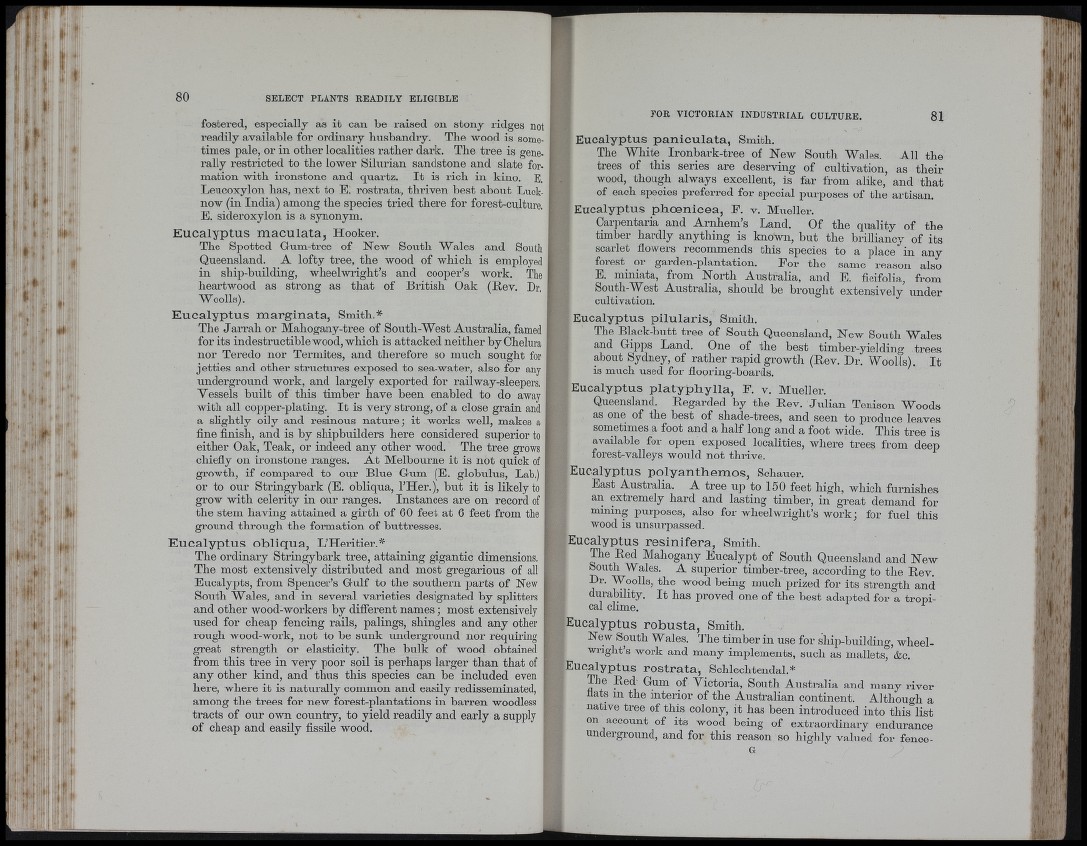
il' .
Il "■
' I, 5 t
ì
I
li
I '
mi
IH
• h,
j
Ì ■ I ■’ '
i . fi
I I ' ‘ >
f:!! ’
80 SELECT PLANTS READILY ELIGIBLE
fostered, especially as it can be raised on stony ridges not
readily available for ordinary husbandry. Tbe wood is sometimes
pale, or in other localities rather dark. The tree is generally
restricted to the lower Silurian sandstone and slate formation
with ironstone and quartz. I t is rich in kino. E.
Leucoxylon has, next to E. rostrata, tluiven best about Lucknow
(in India) among the species tried there for forest-culture.
E. sideroxylon is a synonym.
Eucalyptus maculata, Hooker.
The Spotted Gum-tree of New South Wales and Soiitli
Queensland. A lofty free, the wood of which is employed
in ship-building, wheelwright’s and cooper’s work. Tlie
beartwood as strong as that of British Oak (Rev. Dr
Woolls).
Eucalyptus marginata, Smith.*
The Jarrah or Mahogany-tree of South-West Australia, famed
for its indestructible wood, which is attacked neither by Chelura
nor Teredo nor Termites, and therefore so much sought for
jetties and other structures exposed to sea-water, also for any
underground work, and largely exported for railway-sleepers.
Vessels built of this timber have been enabled to do away
with all copper-plating. I t is very strong, of a close grain anc
a slightly oily and resinous nature; it works well, makes a
fine finish, and is by shipbuilders here considered superior to
either Oak, Teak, or indeed any other wood. The tree grows
chiefly on ironstone ranges. A t Melbourne it is not quick of
growth, if compared to our Blue Gum (E. globulus, Lab.)
or to our Stringybark (E. obliqua, I’Her.), but it is likely to
grow with celerity in our ranges. Instances are on record of
the stem having attained a girth of 60 feet at 6 feet from tbe
ground through the formation of buttresses.
Eucalyptus obliqua, L’Heritier.*
Tbe ordinary Stringybark tree, attaining gigantic dimensions.
The most extensively distributed and most gregarious of all
Encalypts, from Spencer’s Gulf to the southern parts of New
South Wales, and in several A^arieties designated by splitters
and other wood-workers by different names ; most extensively
used for cheap fencing rails, palings, shingles and any other
rough wood-work, not to be sunk underground nor requiring
great streng-th or elasticity. The bulk of wood obtained
from this tree in very poor soil is perhaps larger than that of
any other kind, and thus this species can be included even
here, where it is naturally common and easily redisseminated,
among the trees for new forest-plantations in barren woodless
tracts of onr own country, to yield readily and early a supply
of cheap and easily fissile wood.
FOR VICTORIAN INDUSTRIAL CULTURE. 81
Eucalyptus paniculata, Smith.
The White Ironbark-tree of N cav South Wales. All the
trees of this series are deserving of cultivation, as their
wood, though always excellent, is far from alike, and that
of each species preferred for special purposes of the artisan.
Eucalyptus phoenicea, F. v. Mueller.
Carpentaria and Arnhem’s Land. Of the quality of the
timber hardly anything is known, but the brilliancy of its
scarlet fiowers recommends this species to a place in any
forest or garden-plantation. For the same reason also
E. miniata, from North Australia, and E. ficifolia, from
South-W^est Australia, should be brought extensivelv under
cultivation.
Eucalyptus pilularis, Smith.
The Black-butt tree of South Queensland, New South Wales
and Gipps Land. One of the best timber-yielding trees
about Sydney, of rather rapid growth (Rev. Dr. Woolls). I t
is much used for fiooring-boards.
Eucalyptus platyphylla, F. v. Mueller.
Queensland. Regarded by the Rev. Julian Tenison Woods
as one of the best of shade-trees, and seen to produce leaves
sometimes a foot and a half long and a foot wide. This tree is
available for open exposed localities, where trees from deep
forest-valleys would not thrive.
Eucalyptus polyanthemos, Schauer.
East Australia. A tree up to 150 feet high, which furnishes
an extremely hard and lasting timber, in great demand for
mining purposes, also for wheelwright’s work; for fuel this
wood is unsurpassed.
Eucalyptus resinifera. Smith.
The Red Mahogany Eucalypt of South Queensland and New
South Wales. A superior timber-tree, according to tbe Rev.
Dr. Woolls, tbe wood being much prized for its strength and
durability. I t has proved one of the best adapted for a tropical
clime. ^
Eucalyptus robusta, Smith.
New South Wales. The timber in use for ship-building, wheelwright’s
work and many implements, such as mallets, &c.
Eucalyptus rostrata, Schlechtendal.*
The Red Gum of Victoria, South Australia and many river
flats in the interior of the Australian continent. Although a
native free of this colony, it has been introduced into this list
on account of its wood being of extraordinary endurance
underground, and for this reason so highly valued for fence-
G
1/ q
* Hi' ( *1
!i '4.4
fib
J h ' . l i
' fi’| 1'
rI
, I
I, ".■'.I If '
• 1 i
p
lit
r
! i
■i; ^
I
I 'd